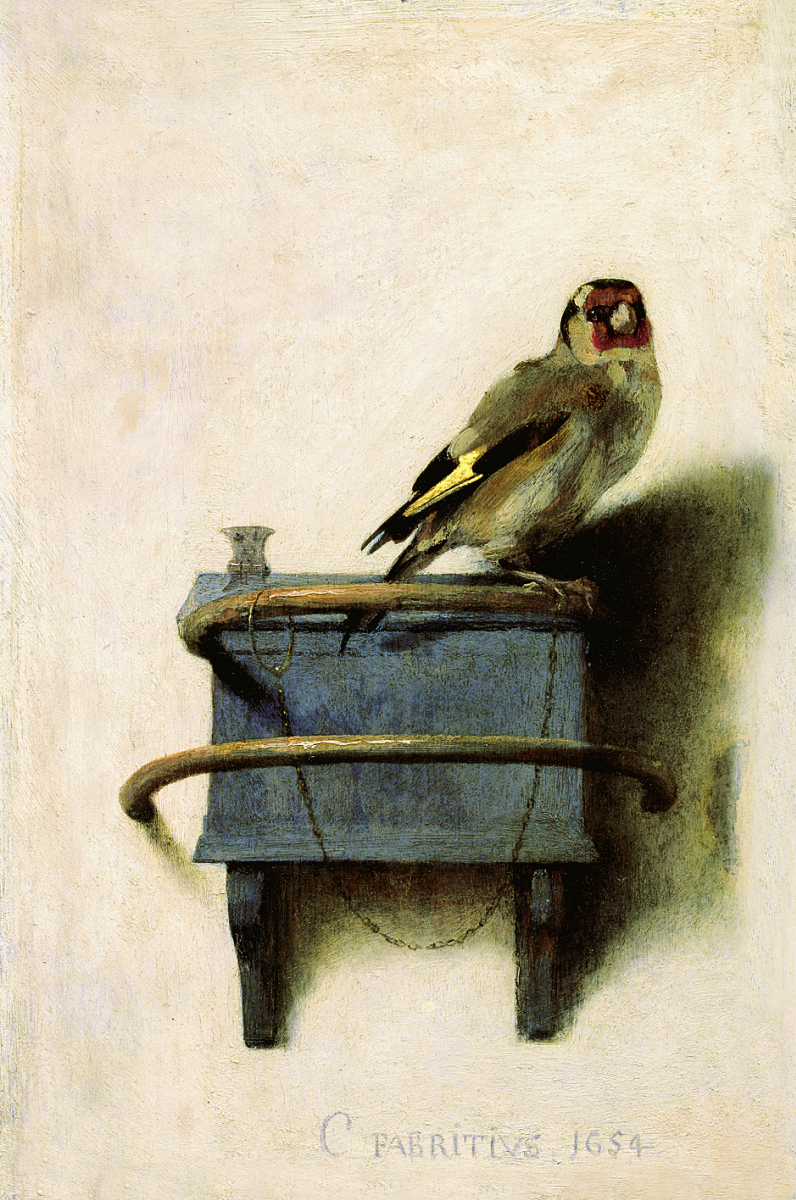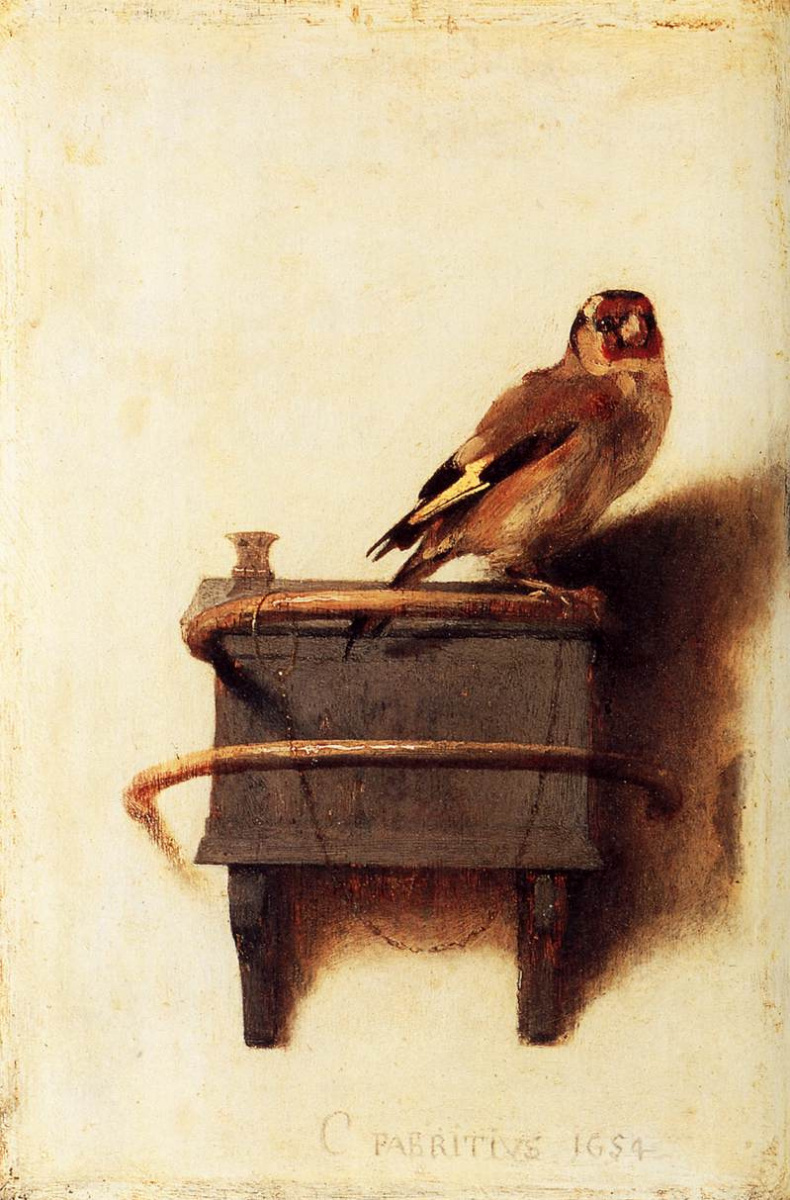log in
Enter site
Login to use Arthive functionality to the maximum
Goldfinch
Karel Fabricius • Painting, 1654, 33.5×22.8 cm
Description of the artwork «Goldfinch»
“A little masterpiece about nothing ... but so beautiful”, - wrote in 1859 the French art critic Theofil Tore-Burger, who rediscovered the work of the artists of the Golden Age of Holland. By “little masterpiece”, the researcher meant “Carduelis” by Karel Fabricius - a picture that some modern experts consider to be one of the most expensive in the world.
Fabricius saw beauty in a laconic combination of black, yellow and red on a white background. Light and shadow, a brilliant bead of the eye. He painted carduelis with free, visible strokes, with a minimum of color and detail. A small bird on a chain in front of a rather modest wall. It's all. Not much, but enough.
Karel Fabricius was born in 1622 - 10 years earlier than Vermeer - and was considered the most talented student Rembrandt. However, he died very young, and now in the world there are (according to the most optimistic estimates) only about a dozen of his paintings. Could he become more famous than his teacher? Who knows.
Theophile Tore-Burger, rediscovered Jan Vermeer,Frans Hals and Karel Fabricius, considered Goldfinch extremely valuable "because "Signatures of the person with whom Vermeer is associated". He noted: “This is a simple studio sketch from the nature of a carduelis sitting on a perch attached to a blurry wall, reminiscent of bleached backgrounds that Vermeer obviously liked so much.”.
There is no doubt that the artist himself greatly appreciated this small panel with an everyday object: he left his signature under it, which was rare in those days. The name of Fabricius in the picture looks as if carved on a white wall.
Carduelis is widespread in Europe, North Africa and Southwest Asia. They can be found both near forests and in cities. In other words, an ordinary little bird. Did Fabricius have his goldfinch? It may very well be. And, perhaps, it was the feathered triviality that made him so attractive for writing: an ideal object for a picture intended to deceive the viewer. These are called "trompley" or "optical illusion."
Did the picture have a frame? Or was she hanging on a bare wall in an artist’s workshop without a frame? Perhaps the visitor entering the studio should have thought for a moment that he was seeing a living bird. In this case, he could not experience anything but admiration for the talent of the master. Perfect business card. Therefore, the panel had to hang high on the wall so that it was visible as best as possible.
Fabrikius’s Goldfinch is undoubtedly the most popular bird in art history. She was not only admired by millions of museum visitors - this is the first picture in the world that has passed through a computer tomograph. It turned out that the artist made it in two stages. On the second, he took off the frame, painted a new white background in the color of the plastered wall, and only added a lower pole over it. Probably, thereby Fabrizius wanted to enhance the effect of trompleya.
"Goldfinch" should deceive the eye, but still the style of Fabricius is not at all "photographic." It’s easy to see his technique nearby: intuitive, with light touches, strokes applied with a thin and thick layer, with spots and scratches. The most obvious is the yellow stripe on the black wing - the artist held it with a brush pen. Rembrandt also acted in his early paintings, whose influence is visible in the free performance of Fabricius. He was a student of the master at the time of writing "Night Watch", and, perhaps, also had a hand in this canvas.
The explosion of the powder shop on October 12, 1654 destroyed a significant part of Delft, including the house of Fabricius. The artist was dragged out from the wreckage after 6-7 hours and taken to the hospital. There “After 15 minutes, his suffering soul left his mortal body”, wrote Arnold Houbraken in his work The Bolshoi Theater of Dutch Artists (1718-21).
Judging by the tiny dents on the colorful surface, during the explosion, "Goldfinch" was in the artist's house - and miraculously survived. But how many paintings were destroyed during the disaster, no one knows. As well as what Karel Fabrizius would have remembered if he had not died at the age of 32 - just a talented student of Rembrandt or a master who exceeded the teacher?
About "Goldfinch" was not known until 1859, when the art critic Tore discovered it in a private collection in Brussels. He did everything possible to leave a picture for himself. "Do not forget that I must have their" Goldfinch "..."- he wrote to a friend in 1861. And it worked: after the death of the owner, with whom the Frenchman maintained good relations, the panel went to him as a gift.
In 1866, Thore exhibited “Carduelis” along with Vermeer's paintings in “Retrospective Exposition”, and a year later the Dutch public first saw work at a show of old masters in the Arti et Amicitiae art society in Amsterdam. In 1896, Fabriceius' little masterpiece returned to Holland forever: it was acquired at an auction in Paris by Abraham Bredius, director of the Royal Gallery Mauritshuis.
In 2014, an expert contacted by Deborah Davis, a biographer of Fabricius, estimated the panel (if it was for sale) at 300 million US dollars. At that time, it was the highest price for a painting ever painted.
"Goldfinch" attracts not only visitors to museums around the world. Fabrizius's painting inspires musicians, filmmakers, authors and designers. The novel of the same name by American writer Donna Tart received the Pulitzer Prize in 2014 (among other literary awards), became a bestseller and formed the basis of the script film released in 2019.
Author: Vlad Maslov (based on materials from the Royal Gallery Mauritshuis)
Fabricius saw beauty in a laconic combination of black, yellow and red on a white background. Light and shadow, a brilliant bead of the eye. He painted carduelis with free, visible strokes, with a minimum of color and detail. A small bird on a chain in front of a rather modest wall. It's all. Not much, but enough.
Karel Fabricius was born in 1622 - 10 years earlier than Vermeer - and was considered the most talented student Rembrandt. However, he died very young, and now in the world there are (according to the most optimistic estimates) only about a dozen of his paintings. Could he become more famous than his teacher? Who knows.
Theophile Tore-Burger, rediscovered Jan Vermeer,Frans Hals and Karel Fabricius, considered Goldfinch extremely valuable "because "Signatures of the person with whom Vermeer is associated". He noted: “This is a simple studio sketch from the nature of a carduelis sitting on a perch attached to a blurry wall, reminiscent of bleached backgrounds that Vermeer obviously liked so much.”.
There is no doubt that the artist himself greatly appreciated this small panel with an everyday object: he left his signature under it, which was rare in those days. The name of Fabricius in the picture looks as if carved on a white wall.
Carduelis is widespread in Europe, North Africa and Southwest Asia. They can be found both near forests and in cities. In other words, an ordinary little bird. Did Fabricius have his goldfinch? It may very well be. And, perhaps, it was the feathered triviality that made him so attractive for writing: an ideal object for a picture intended to deceive the viewer. These are called "trompley" or "optical illusion."
Did the picture have a frame? Or was she hanging on a bare wall in an artist’s workshop without a frame? Perhaps the visitor entering the studio should have thought for a moment that he was seeing a living bird. In this case, he could not experience anything but admiration for the talent of the master. Perfect business card. Therefore, the panel had to hang high on the wall so that it was visible as best as possible.
Fabrikius’s Goldfinch is undoubtedly the most popular bird in art history. She was not only admired by millions of museum visitors - this is the first picture in the world that has passed through a computer tomograph. It turned out that the artist made it in two stages. On the second, he took off the frame, painted a new white background in the color of the plastered wall, and only added a lower pole over it. Probably, thereby Fabrizius wanted to enhance the effect of trompleya.
"Goldfinch" should deceive the eye, but still the style of Fabricius is not at all "photographic." It’s easy to see his technique nearby: intuitive, with light touches, strokes applied with a thin and thick layer, with spots and scratches. The most obvious is the yellow stripe on the black wing - the artist held it with a brush pen. Rembrandt also acted in his early paintings, whose influence is visible in the free performance of Fabricius. He was a student of the master at the time of writing "Night Watch", and, perhaps, also had a hand in this canvas.
The explosion of the powder shop on October 12, 1654 destroyed a significant part of Delft, including the house of Fabricius. The artist was dragged out from the wreckage after 6-7 hours and taken to the hospital. There “After 15 minutes, his suffering soul left his mortal body”, wrote Arnold Houbraken in his work The Bolshoi Theater of Dutch Artists (1718-21).
Judging by the tiny dents on the colorful surface, during the explosion, "Goldfinch" was in the artist's house - and miraculously survived. But how many paintings were destroyed during the disaster, no one knows. As well as what Karel Fabrizius would have remembered if he had not died at the age of 32 - just a talented student of Rembrandt or a master who exceeded the teacher?
About "Goldfinch" was not known until 1859, when the art critic Tore discovered it in a private collection in Brussels. He did everything possible to leave a picture for himself. "Do not forget that I must have their" Goldfinch "..."- he wrote to a friend in 1861. And it worked: after the death of the owner, with whom the Frenchman maintained good relations, the panel went to him as a gift.
In 1866, Thore exhibited “Carduelis” along with Vermeer's paintings in “Retrospective Exposition”, and a year later the Dutch public first saw work at a show of old masters in the Arti et Amicitiae art society in Amsterdam. In 1896, Fabriceius' little masterpiece returned to Holland forever: it was acquired at an auction in Paris by Abraham Bredius, director of the Royal Gallery Mauritshuis.
In 2014, an expert contacted by Deborah Davis, a biographer of Fabricius, estimated the panel (if it was for sale) at 300 million US dollars. At that time, it was the highest price for a painting ever painted.
"Goldfinch" attracts not only visitors to museums around the world. Fabrizius's painting inspires musicians, filmmakers, authors and designers. The novel of the same name by American writer Donna Tart received the Pulitzer Prize in 2014 (among other literary awards), became a bestseller and formed the basis of the script film released in 2019.
Author: Vlad Maslov (based on materials from the Royal Gallery Mauritshuis)





